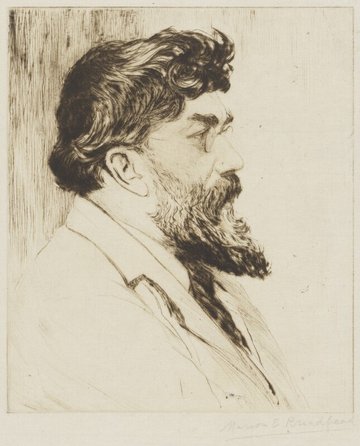
George Russell (AE)
‐
Writer and member of the Theosophical Society
Other names
AE
George William Russell
Place of birth
About
A chance reading of the Upanishads in the mid-1880s, and a friendship with Charles Johnston from 1885, led George William Russell (known as AE) to a study of the Upanishads and the Bhagavad Gita. Russell was drawn into Theosophical circles through Johnston and W. B. Yeats. In 1885 he met Mohini Chatterjee in Dublin and was greatly impressed by him. This acquaintance encouraged Russell to pursue his study of Indian philosophy and literature further. In 1890 Russell gave up art school, formally joined the Theosophical Society and dedicated the next seven years to pursuing 'the path of mysticism'. Russell spent a lot of time in meditation and became interested in yoga. Hindu and Buddhist philosophy became an influence on his poetry and artistic works, although he was also inspired by visions and his 'natural mysticism'.
Russell was known for his thorough knowledge of the Bhagavad Gita and this led to interactions with South Asian visitors to the UK, as did his friendship with Yeats. When Purohit Swami arrived in the UK in 1930, he came bearing a letter of introduction to Russell written by E. E. Speight. In Yeats' introduction to the translation of The Ten Principal Upanishads by Yeats and Purohit Swami (1937), he drew attention to the influence of Russell on him. Yeats told how Russell had been quoting the Upanishads for the 'last forty years'. Russell also had connections with Rabindranath Tagore and Ranjee G. Shahani. Shahani remarks in a letter to Tagore in 1934 that AE had often spoken of Tagore to him. In 1931 Russell was invited to meet Mahatma Gandhi in London, whose theory of non-violence had been advocated by Russell in The Interpreters, but was unable to meet him as his wife fell ill.
Works include (in chronological order):
The Earth Breath and Other Poems (London: John Lane, 1897)
The Divine Vision and Other Poems (New York: Macmillan, 1904)
Imaginations and Reveries (Dublin and London: Maunsel, 1915)
The Candle of Vision (London: Macmillan, 1918)
The Interpreters (London: Macmillan, 1922)
Song and Its Fountains (London: Macmillan, 1932)
The Living Torch (London: Macmillan, 1937)
Kuch, Peter R., ‘Russell, George William (1867–1935)’, Oxford Dictionary of National Biography, (Oxford University Press, 2004) [http://www.oxforddnb.com/view/article/35880]
Kuch, Peter, Yeats and A.E. 'The antagonism that unites dear friends' (Gerrards Cross: Colin Smythe, 1986)
Lennon, Joseph, Irish Orientalism (Syracuse, NY: Syracuse University Press, 2004)
Summerfield, Henry, That Myriad-Minded Man: A Biography of George William Russell 'AE' 1867–1935 (Gerrards Cross: Colin Smythe, 1975)
Papers, Armagh County Museum, Northern Ireland
Some Correspondence Files, Manuscript Collection, British Library, St Pancras
Correspondence Files in Lilly Library, Indiana University, Bloomington
Papers, National Library of Ireland, Dublin
Image credit
George William Russell by Marion E. Broadhead, etching, 1920s?, NPG 5905
© National Portrait Gallery, London, Creative Commons, http://creativecommons.org/licenses/by-nc-nd/3.0/
